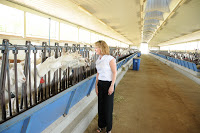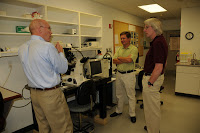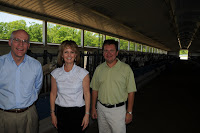From Humble Farm Animals



I’ve been to a lot of places recently, and one of the most interesting ones was the GTC Biotherapeutics farm in Charlton, Massachusetts, on Friday, May 21, to see transgenic goats.
We wrote about transgenic animals in the February issue of PEN, when I discussed hemophilia products that are being developed now. Factor produced through transgenic animals may one day become a source of factor concentrate. And if production proceeds as hoped, transgenic animals may represent a high volume and thus low-cost way to produce factor and other proteins. 
What are transgenic animals? These are animals that have been genetically modified to express human therapeutic proteins in their milk. In other words, human factor can be collected by milking these animals. The source material is raw milk. And once the proteins are collected and purified, they can be used to treat diseases and genetic or metabolic disorders in humans.
Now, the goats located on the 167 acres that bridge the towns of Charlton and Spencer, Massachusetts, are not being raised to create factor, although factor IX is being produced by transgenic pigs in Virginia, and factor VII is being made by transgenic rabbits in France. The goats we visited express the protein used in ATryn®, a recombinant form of human antithrombin. Atryn® is the first transgenically produced therapeutic protein to receive FDA approval and the first recombinant antithrombin approved in the U.S. So as wild as this all sounds, GTC already has an FDA-approved, transgenically produced therapeutic in the marketplace. And GTC is hoping to initiate a clinical trial for their factor VIIa product later this year.
I requested a tour, and was enthusiastically greeted by Ashley Lawton, Vice President, Business Development. Before I entered the building, I had to dip my shoes into a disinfectant solution, to kill any microbes. Of course, I was wearing sandals!
Safety was stressed at every part of the two-hour tour.
Ashley told us that the goats originated from New Zealand, because this is one of the few countries free of scrapie, a fatal and degenerative disease in sheep and goats. Why use goats and not cows? Goats produce more milk and their milk has a high protein content; they also have a four-month gestation period. And they are relatively easy to breed and maintain.
GTC is a pioneer in the field of transgenic technology, and because it involves making human therapeutic proteins, regulatory agencies want extensive documentation. Everything done to the animals, from having their hoofs cleaned to operations, is documented fully.
.
Dr. Bill Gavin, General Manager of Operations and chief veterinarian, joined our tour and told me, “Because we were a new technology… we were held to an even higher level of safety.”
We toured the labs where the genes are spliced into the embryos. We traveled to the barns where the goats are penned. Somehow I expected sterile, see-through cubes with goats hooked up to machines. Instead, we saw adorable goats comfy in stalls, much like you’d see on any farm. The “kids” were cuddled together. Young adults were able to mingle and hang together; they even had toys to play with like bouncing balls. Goats love to climb, and these had cubes to scale. 
Goats are fascinating. They are curious, sociable and always hungry! They’ll nibble on anything and eat just about anything. I couldn’t go too near them but got close enough to see these are probably the best cared for goats on earth.
I’ve been invited to view the pigs in Virginia that are being researched currently to produce factor IX; after this trip I think I need to go check it out. 

Actually seeing the goats and the technology made this seem more than just a pipedream. Perhaps the biggest revelation is that we would not “drink” the treatment, which I actually believed! Once the protein is purified from the milk, it will be freeze-dried and prepared as an injectible, biological product, very much like the factor concentrates available on the market today.
I know there are those in our community who might think this is unfeasible. But for me, this is a ray of hope. Transgenic animals might be particularly attractive as a way to treat hemophilia in developing countries, where there is great need for a low cost product, and plenty of it. Do you know which countries are the top five in population?
In order: China, India, US, Indonesia, Brazil. Four of the five most populated countries on earth are developing countries. So it stands to reason that a huge population of people with hemophilia are underserved and in need. This wonderful tour on a warm spring day left me hopeful that plentiful help for them might someday come from this fascinating new technology from humble farm animals.
Interesting Book I Just Read
The Seven Powers of Questions
By Dorothy Leeds
This book asks questions, actually: why do we talk so much and not listen? How can we better focus and learn? What are effective ways to ask questions? Leeds covers a lot of ground about how we communicate, mistakes we make in trying to form relationships (whether business or personal), and how to be a better listener. Asking questions makes us better listeners, helps us to focus, diffuse defensiveness in others, calms situations. She notes the things that make us poor listeners: having preconceived ideas, jumping to conclusions, being emotionally charged. Questions help break down those barriers, and make us more open to listen, and then to think. This book got off to a very weak start (I think it was opening with a not-so-good quote from the 1960s Star Trek TV show [and I consider myself a fan]) with a plethora of cliché quotations from oft-referenced works (Ask a better question to get a better answer: how many times have I heard that?) and also had a weak ending, by evolving into a “Where is your entire life going and how will you get motivated to be an empowered person and make your dreams come true…” But overall there is material that is vital to know and this book will be welcome to read if you are new to self-help books or any book on communication. Two stars.


